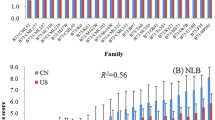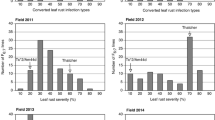Abstract
Northern corn leaf blight (NCLB) caused by Exserohilum turcicum, gray leaf spot (GLS) caused by Cercospora zeae-maydis and maize streak caused by maize streak Mastrevirus (MSV) are the most destructive foliar diseases limiting maize production in sub-Saharan Africa. Most foliar diseases of maize are managed using quantitative (partial) resistance, and previous studies have reported quantitative trait loci associated with host resistance (rQTL). Our objective was to compare the genetic gain and costs resulting from phenotypic, genotypic, and marker-assisted selection of partially inbred lines derived from many families for resistance to infection by three foliar pathogens. We developed a population of 410 F2:3 families by crossing inbred line CML202 with a breeding line designated VP31. These families were planted in nurseries inoculated separately with each pathogen. We conducted one cycle of early generation pedigree selection using three different procedures, phenotypic, genotypic, and marker/phenotypic index, for improvement of resistance to each pathogen. We used simple sequence repeat (SSR) markers flanking six target rQTL associated with partial resistance. Broad- and narrow-sense heritability estimates were also obtained for the F2:3 families, and selected and non-selected F2:4 families. Genetic gains resulting from the selection procedures were determined. Gene action of the candidate rQTL was determined using orthogonal contrasts. Estimates of costs based on lower boundary values indicated that the cost of marker-based selection was lower than that of phenotypic selection. Our results indicate that molecular markers linked to target rQTL can facilitate pyramiding resistance to multiple diseases during early generation pedigree selection.

Similar content being viewed by others
Abbreviations
- CIMMYT:
-
International Maize and Wheat Improvement Center
- GLS:
-
Gray leaf spot
- MAS:
-
Marker-assisted selection
- MSV:
-
Maize streak virus
- NCLB:
-
Northern corn leaf blight
- rQTL:
-
Resistance quantitative trait locus/loci
- SSR:
-
Simple sequence repeat
References
Abalo G, Edema R, Derera J, Tongoona P (2009) A comparative analysis of conventional and marker-assisted selection methods in breeding maize streak virus resistance in maize. Crop Sci 49:509–520
Allard RW (1964) Principles of plant breeding. Wiley, New York
Asea G, Vivek B, Bigirwa G, Lipps PE, Pratt RC (2009) Validation of consensus quantitative trait loci for resistance to multiple foliar pathogens of maize. Phytopathology 99:540–547
Balint-Kurti PJ, Johal GS (2008) Maize disease resistance. In: Bennetzen JL, Hake SC (eds) Maize genetics handbook: its biology. Springer, New York, pp 251–270
Bernardo R (2002) Breeding for quantitative traits in plants. Stemma Press, Woodbury
Bernardo R (2008) Molecular markers and selection of complex traits in plants. Crop Sci 48:1649–1664
Bigirwa G, Pratt RC, Adipala E, Lipps PE (2001) Assessment of gray leaf spot and stem borer incidence and severity on maize in Uganda. Afric Crop Sci Conf Proc 4:469–474
Bosque-Perez NA (2000) Eight decades of maize streak virus research. Virus Res 71:107–121
Bubeck DM, Goodman MM, Beavis WD, Grant D (1993) Quantitative trait loci controlling resistance to gray leaf spot in maize. Crop Sci 33:838–847
Carson ML, Goodman MM, Williamson SM (2002) Variation in aggressiveness among isolates of Cercospora from maize as a potential cause of genotype-environment interaction in gray leaf spot trials. Plant Dis 86:1089–1093
Castro AJ, Chen X, Hayes P, Johnston M (2003) Pyramiding quantitative trait locus (QTL) alleles determining resistance to barley stripe rust: effects on resistance at the seedling stage. Crop Sci 43:651–659
Clements MJ, Dudley JW, White DG (2000) Quantitative trait loci associated with resistance to gray leaf spot of corn. Phytopathology 90:1018–1025
Coaker GL, Meulia T, Kabelka E, Jones AK, Francis DM (2002) A QTL controlling stem morphology and vascular development in Lycopersicon esculentum × Lycopersicon hirsutum (Solanaceae) crosses is located on chromosome 2. Am J Bot 89:1859–1866
Dreher K, Khairallah M, Ribaut J, Morris M (2003) Money matters (I): costs of field and laboratory procedures associated with conventional and marker-assisted maize breeding at CIMMYT. Mol Breed 11:221–234
Dudley JW (1993) Molecular markers in plant improvement: manipulation of genes affecting quantitative traits. Crop Sci 33:660–668
Eathington SR, Dudley JW, Rufener GK (1997) Usefulness of marker-QTL associations in early generation selection. Crop Sci 37:1686–1693
Flint-Garcia SA, Darrah LL, McMullen MD (2003) Phenotypic versus marker-assisted selection for stalk strength and second-generation European corn borer resistance in maize. Theor Appl Genet 107:1331–1336
Foolad MR, Subbiah P, Ghangas GS (2002) Parent-offspring correlation estimate of heritability for early blight resistance in tomato, Lycopersicon esculentum Mill. Euphytica 126:291–297
Freymark PJ, Lee M, Woodman WL, Martinson CA (1993) Quantitative and qualitative trait loci affecting host-plant response to Exserohilum turcicum in maize (Zea mays L.). Theor Appl Genet 87:537–544
Gordon SG, Bartsch M, Matthies I, Lipps PE, Gevers HO, Pratt RC (2004) Linkage of molecular markers to Cercospora zeae-maydis in maize. Crop Sci 44:628–636
Hakiza JJ, Lipps PE, St. Martin S, Pratt RC (2004) Heritability and number of genes controlling partial resistance to Exserohilum turcicum in maize inbred H99. Maydica 49:173–182
Holland JB (2003) Estimating and interpreting heritability for plant breeding: an update. Plant Breed Rev 22:9–112
Hospital F, Charcosset A (1997) Marker-assisted introgression of quantitative trait loci. Genetics 147:1469–1485
Kyetere DT, Ming R, McMullen MD, Pratt RC, Brewbaker J, Musket T (1999) Genetic analysis of tolerance to maize streak virus in maize. Genome 42:20–26
Lande R, Thompson R (1990) Efficiency of marker-assisted selection in the improvement of quantitative traits. Genetics 124:743–756
Moreau L, Charcosset A, Hospital F, Gallais A (1998) Marker-assisted selection efficiency in populations of finite size. Genetics 148:1353–1365
Moreau L, Lemarie S, Charcosset A, Gallais A (2000) Economic efficiency of one cycle of marker-assisted selection. Crop Sci 40:329–337
Morris M, Dreher K, Ribaut J, Khairallah M (2003) Money matters (II): costs of maize inbred line conversion schemes at CIMMYT using conventional and marker-assisted selection. Mol Breed 11:235–247
Nicholas FW (2006) Discovery, validation and delivery of DNA markers. Aust J Exp Agr 46:155–158
Pernet AD, Hoisington J, Franco M, Isnard M, Jewel C, Jiang C, Marchand JL, Reynaud B, Glaszmann JC, Gonzalez De Léon D (1999a) Genetic mapping of maize streak virus resistance from the Mascarene source I. Resistance in line D211 and stability against different virus clones. Theor Appl Genet 99:524–539
Pernet AD, Hoisington J, Dintinger D, Jewel C, Jiang C, Khairallah M, Letourmy P, Marchand JL, Glaszmann JC, Gonzalez De Léon D (1999b) Genetic mapping of maize streak virus resistance from the Mascarene source II. Resistance in line CIRAD390 and stability against across germplasm. Theor Appl Genet 99:540–553
Poland JA, Balint-Kurti PJ, Wisser RJ, Pratt RC, Nelson RJ (2009) Shades of gray: the world of quantitative disease resistance. Trends Plant Sci 14:21–29
Pratt RC, Gordon SG (2006) Breeding for resistance to maize foliar pathogens. Plant Breed Rev 27:119–173
Redinbaugh M, Pratt RC (2009) Virus Resistance. In: Bennetzen JL, Hake SC (eds) Handbook of maize: its biology, 2nd edn. Springer, New York, pp 251–270
Robert VJM, West MAL, Inai S, Caines A, Arntzen L, Smith JK, St Clair DA (2001) Marker-assisted introgression of blackmold resistance QTL alleles from wild Lycopersicon cheesmanii to cultivated tomato (L. esculentum) and evaluation of QTL phenotypic effects. Mol Breed 8:217–233
Rodier A, Assie J, Marchand J-L, Herve Y (1995) Breeding maize lines for complete and partial resistance to maize streak virus (MSV). Euphytica 81:57–70
Saghai-Maroof MA, Yue YG, Xiang ZX, Stromberg EL, Rufener GK (1996) Identification of quantitative trait loci controlling resistance to gray leaf spot. Theor Appl Genet 93:539–546
Schechert AW, Welz HG, Geiger HH (1999) QTL for Resistance to Setosphaeria turcica in tropical African maize. Crop Sci 39:514–523
Servin B, Martin OC, Mezard M, Hospital F (2004) Toward a theory of marker-assisted gene pyramiding. Genetics 168:513–523
Simmonds NW, Smartt J (1999) Principles of crop improvement. Blackwell
Welz HG, Geiger HH (2000) Genes for resistance to northern corn leaf blight in diverse maize population. Plant Breed 119:1–14
Welz HG, Schechert A, Pernet A, Pixley K, Geiger HH (1998) A gene for resistance to the maize streak virus in the African CIMMYT maize inbred line CML202. Mol Breed 4:147–154
Welz HG, Schechert AW, Geiger HH (1999a) Dynamic gene action at QTLs for resistance to Setosphaeria turcica in maize. Theor Appl Genet 98:1036–1045
Welz HG, Xia XC, Bassetti P, Melchinger AE (1999b) QTLs for resistance to Setosphaeria turcica in an early maturing Dent × Flint maize population. Theor Appl Genet 99:649–655
Wisser RJ, Balint-Kurti PJ, Nelson RJ (2006) The genetic architecture of disease resistance in maize: a synthesis of published studies. Phytopathology 96:120–129
Yousef GG, Juvik JA (2001) Comparison of phenotypic and marker-assisted selection for quantitative traits in sweet corn. Crop Sci 41:645–655
Acknowledgments
We thank David Francis and Steve St. Martin for reviewing earlier drafts of the manuscript. We are especially grateful to Mark Casey, Sebastian Mawere and Audrey Johnston who provided valuable technical assistance. G. Asea received support from Integrated Pest Management/Cooperative Research Support Program (IPM/CRSP) grant No. CR-19053-425231 from the US Agency for International Development (USAID). Salaries and research support were provided by state and federal funds appropriated to The Ohio State University, Ohio Agricultural Research and Development Center (OARDC). This manuscript was published as OARDC manuscript number HCS09-12. The mention of names of firms or trade products does not imply that they are endorsed or recommended by The Ohio State University over other firms or similar products not mentioned.
Author information
Authors and Affiliations
Corresponding author
Rights and permissions
About this article
Cite this article
Asea, G., Vivek, B.S., Lipps, P.E. et al. Genetic gain and cost efficiency of marker-assisted selection of maize for improved resistance to multiple foliar pathogens. Mol Breeding 29, 515–527 (2012). https://doi.org/10.1007/s11032-011-9568-8
Received:
Accepted:
Published:
Issue Date:
DOI: https://doi.org/10.1007/s11032-011-9568-8




